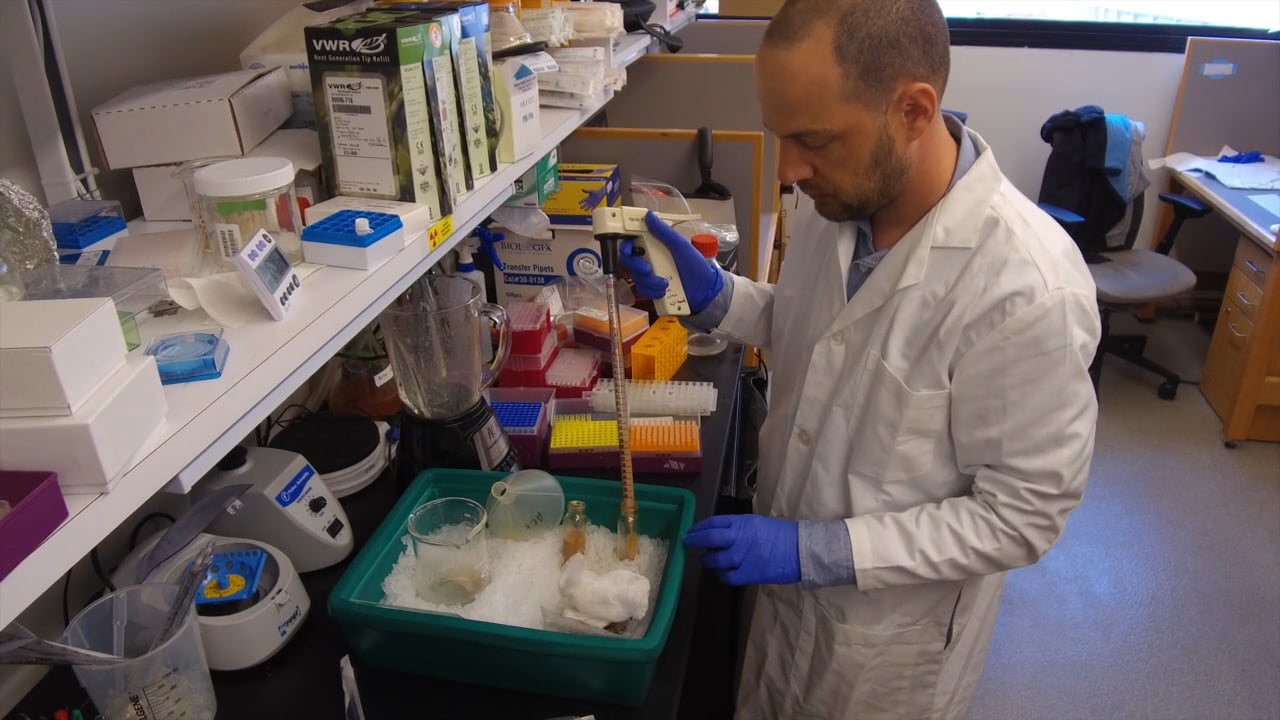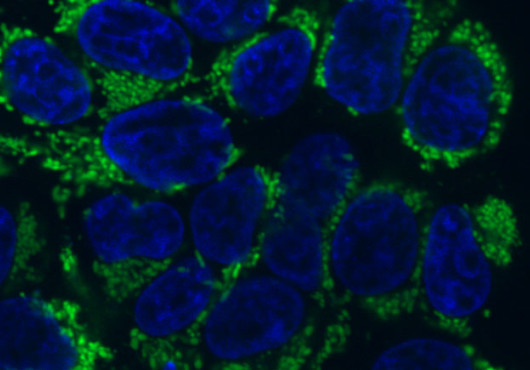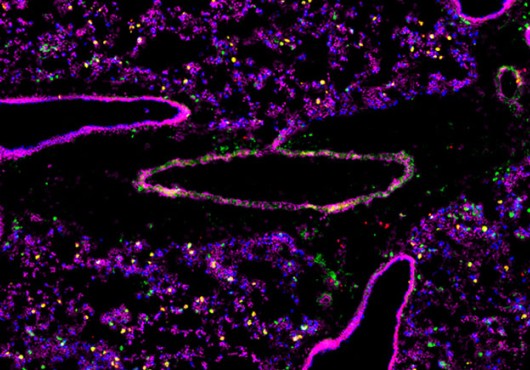
Ingredients:
- 3 to 4 frozen calf livers (about 1.5 lbs)
- Saline solution
Directions:
- Thaw the livers, then dice into 1-cm cubes.
- Add cubes to blender and pour in saline solution. Process until smooth.
- Spin mixture in a centrifuge for 20 minutes. Drain excess liquid. You should be left with a mush that contains the ground-up liver membranes.
- Add saline and spin again. Repeat until liquid runs clear and membrane bits are clean, about 5 to 10 washes.
Following these steps and the dozens that come after won’t produce a tasty dinner, even if you like liver. Instead, the “recipe,” crafted by Harvard Medical School biochemists, has revealed the identity of an elusive protein linked to cancer and neurodegenerative diseases.
For decades, researchers have attempted to unmask a shadowy receptor in our cells, known as sigma-2. They figured out that sigma-2 is present in the liver, kidneys and central nervous system, and they stumbled upon drugs that bind to it, but they couldn’t unlock its structure or function.
By taking an unconventional approach to the problem, the HMS scientists and their colleagues have at last discovered what sigma-2 really is: transmembrane protein (TMEM) 97, known to regulate cellular cholesterol levels.
The discovery, published May 30 in PNAS, solves a 30-year mystery that has “crippled” investigations into exactly how sigma-2 is involved in Alzheimer’s disease, schizophrenia and several types of cancer and how the receptor might be manipulated to treat those diseases, the study authors said.
“I hope our identification of sigma-2 will lead to a detailed molecular understanding of how this unusual receptor works and what happens when drugs act on it,” said Andrew Kruse, assistant professor of biological chemistry and molecular pharmacology at HMS and senior author of the paper. “In the long term, if we want to treat conditions that haven’t been effectively treated before, we need to understand their fundamental biology.”
The findings also may open new doors for understanding and devising treatments for Niemann-Pick disease type C, a fatal disorder in which a person’s cells can’t metabolize cholesterol and other fats. Studies suggest TMEM97 influences levels of a protein that causes the disease. With the revelation that TMEM97 is the same as sigma-2, the well-stocked toolbox scientists have built to study sigma-2 can now be applied to Niemann-Pick as well.
A fresh look
Sigma receptors were discovered in 1976. In the ensuing years, scientists lifted several layers of the shroud surrounding sigma-1, which has been linked to neurodegeneration, addiction and pain; in 2016, the Kruse lab uncovered its atomic structure. But despite its own compelling links to health and disease, sigma-2 remained stubbornly in the shadows.
Instead of treading the same fruitless paths others had attempted, Kruse took a step back and reevaluated assumptions the field had made.
“We tried to start from the ground up for each step,” he said.
First, those on the hunt to identify sigma-2 had been either culturing mammalian cell lines—a technique that is expensive to do in bulk—or studying rat livers, which are small and hard to acquire in sufficient quantities. Kruse decided to try a cheap and scalable alternative: calf livers.
His lab bought a dozen livers from a mail-order steak company for about $20. They were flash-frozen, so the tissue was well-preserved once thawed. Tests indicated the inexpensive organs were “at least as good, if not better” than what other scientists had been using, said Kruse.
The researchers optimized every step as they designed their recipe to extract, purify and identify sigma-2. Crucially, Kruse’s group partnered with synthetic chemists at the University of Texas at Austin to build a molecule that bound to sigma-2. That allowed them to capture enough sigma-2 molecules within the liver purée that a mass spectrometer—a device that separates particles by weight—could detect them along with the hundreds of other proteins in the sample.
“It’s nice to finally know its identity so we can bring sigma-2 into the modern age of biology.”
—Andrew Kruse
The researchers tested seven of the most promising proteins. Their experiments narrowed the candidates to a single finalist: TMEM97. Another set of tests confirmed the match.
The simple yet creative approach allowed the team to achieve what others had not.
“The field hasn’t been able to investigate what sigma-2 does and how it works because we didn’t know the gene that encoded it,” said Kruse. “It’s nice to finally know its identity so we can bring sigma-2 into the modern age of biology.”
Building better drugs
Clinical trials are already in progress for drugs that target sigma-2 to combat breast cancer, Alzheimer’s disease and schizophrenia. Unveiling the receptor’s identity lays the groundwork to help researchers understand what these drugs actually do and, perhaps, design new ones that manipulate sigma-2 effectively and exclusively.
“It’s not clear whether these drugs are mediated by sigma-2 or some other pathway,” said Kruse. “It’s also not clear what the mechanism of action is, such as whether sigma-2 is being activated or inhibited.”
Other exciting avenues for investigation include deciphering how sigma-2 changes under different treatments and testing compounds that target the receptor in a mouse model of schizophrenia—“something no one has been able to do,” Kruse said.
Postdoctoral researcher Assaf Alon and graduate student Hayden Schmidt of the Kruse lab, along with graduate research assistant Michael Wood in the lab of Stephen F. Martin at UT Austin, were co-first authors of the paper.
The study authors have applied for a patent related to this work.
Funding for this research was provided by National Institutes of Health grant 1DP5OD021345, the Vallee Scholars Program, the Harvard Brain Science Initiative Winthrop Fund, the Klingenstein–Simons Fellowship Program, Welch Foundation Grant F-0652, the donors of the Alzheimer’s Disease Research Program, the BrightFocus Foundation and Dell Medical School’s Texas Health Catalyst Program. The authors also acknowledge National Institute of Mental Health contract HHSN-271-2013-00017-C and the HMS Center for Macromolecular Interactions.





